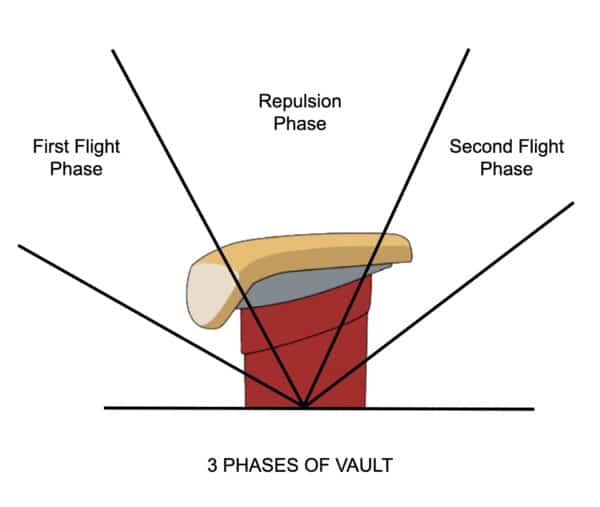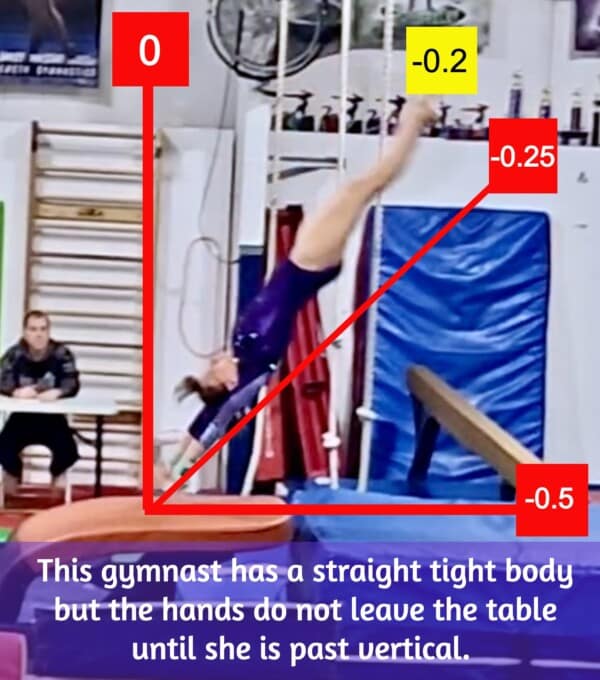Gymnastics Vault Scoring: What Judges See That You Don’t
Have you ever sneezed during a gymnastics vault and when you looked back, you only saw the landing? How can a judge possibly come up with a score on an event that lasts for just two seconds!
The gymnastics scoring system for vault is entirely different than the system used for bars, beam, and floor. There are no Special Requirements or Value Parts on vault, unlike all the other events.
This article is not going to delve into all the possible deductions a judge can take for each Excel division or Developmental Program level. Instead, it will point out some of the not-so-obvious things to watch for that will help you understand how the judge arrived at that final score. There are some critical things the judge sees that you will also (hopefully) be able to see after your eyes are opened to the mysterious world of judging a gymnastics vault!

Gymnastics Vault Start Values
Though there are no Special Requirements or Value Parts in vaults, there are still Start Values. Each vault has its own assigned Start Value.
At the beginner Excel divisions, Bronze, Silver, and Gold, the Start Values are 10.0. There are also some simplified versions of the vault that coaches can choose to compete which have Start Values of either 9.0 or 9.5.
Levels 4 and 5 do a handspring over the table with a Start Value of 10.0.
Levels 6 and 7 have three vaults to choose from, each valued at 10.0.
Beginning with the Xcel Platinum division and Level 8, Start Values range according to the difficulty of the vault and the expectation of the division or level. For example, if a Platinum gymnast performs a front handspring, her Start Value is 9.7 instead of 10.0. The same vault performed by a Level 8 drops to a 9.0. And a Level 9 would need to perform a front handspring with a full twist in order to receive a 9.0 Start Value.
Execution deductions are taken in all phases of the vault. These are subtracted from the vault’s Start Value.
3 Phases of a Gymnastics Vault
With the exception of Xcel Bronze, which is covered below, every gymnastics vault has three phases: first flight, repulsion, and second flight. Though there are specific deductions that apply for different types of vaults, they are still divided into these three separate phases and judged separately.
For example, if a gymnast has an arched body in each phase, she will receive a deduction during each phase. The deductions referred to in this article apply primarily to forward entry vaults including handsprings and Tsukaharas, two commonly seen vaults. But all vaults, including roundoff entry vaults, have three phases.
In addition to these three phases, general deductions also apply for bent arms, bent or separated legs and foot form.
Let’s take a closer look at each of these phases to learn what judges are looking for during each of them.
Note: DP = Developmental Program referring to levels 4-10.
First Flight
During this first phase, judges want to see:
- body at a 45 degree angle below vertical before hands hit the table.
- body in a straight position at the time the hands hit the table.
- head in neutral position between shoulders with no shoulder angle.
Possible deductions:
- body position errors: up to 0.3 (Silver = 0.5)
- incorrect leg form: up to 0.3

Repulsion
This phase is where the most significant deductions occur with a notable difference in deductions between Excel and the DP levels.
The gymnast should be in vertical position on the top of the table for only a split second. Her hands must quickly block off the table at vertical, and show sufficient height. Without a quick block, the judge also takes an additional deduction for the hands being on the table too long.
Possible deductions in addition to body position errors:
- insufficient height from the block: up to 0.5
- angle at which gymnast leaves the table:
- up to 0.5 for Excel
- up to 1.0 for DP
- too long in support: up to 0.5 (Silver = 0.3)
- arm bend: up to 0.5
- head touching table: 2.0

Second Flight
During this phase, the judge wants so see a straight tight body maintained.
Possible deductions:
- body position errors: up to 0.3 (Silver = 0.5)
- incorrect leg form: up to 0.3
Landing
Landings can make or break a vault! Poor landings have been the demise of many otherwise well executed vaults. Sticking the landing of a powerful vault requires a great deal of precision and depends on the accuracy of everything that has preceded it.
Judges want to see a solid landing at sufficient distance and centered in front of the table with no extra body movements. Arm swings, trunk movements, hops or steps all incur deductions.
Possible deductions:
- insufficient distance from the table: up to 0.3
- squatting: up to 0.3
- steps: up to 0.4
- body posture faults: up to 0.5
- support on the landing mat with hands and falls: 0.5
Scoring the Bronze Gymnastics Vault
Bronze gymnasts may choose between two vaults. The first option does not have phases. Its purpose is to focus on other aspects that prepare them for the handspring which follows.
Both options are subject to general deductions including:
- piked body: up to 0.5
- arched body: up to 0.3
- leg separation: up to 0.2
Option 1: Start Value 9.0
This vault has two parts, each valued at 4.5.
Part 1: Straight jump onto a mat stack.
Judges are looking for:
- good height off the springboard
- a straight, tight body position
- a stuck landing on the mat stack with feet close together
Possible deductions:
- lack of height off springboard onto the mat: up to 0.5
- arms not stretched to vertical: up to 0.3
- tucked knees: up to 0.5
- uncontrolled landing: up to 0.5
- double bounce on springboard: 0.3
- stepping up onto the mat or landing on hands or knees results in a zero for this part of the vault.
Part 2: Kick to handstand and fall to flat back position
Judges are looking for:
- arms have remained vertical while moving into the handstand
- straight arms
- no shoulder angle
Possible deductions:
- arms drop below vertical: up to 0.2
- extra kick to handstand: 0.5
- bent arms: up to 0.5
- shoulder angle once the hands touch the mat: up to 0.3
- rolling into a flat lying position instead of falling from a handstand: up to 2.0

Option 2: Start Value 10.0
Jump to handstand, fall to flat back on mat stack
Judges are looking for proper body position during each phase. General deductions listed above are applied to each phase.
Possible deductions:
- bent legs: up to 0.3
- leg separation: up to 0.2
- bent arms: up to 0.5
- shoulder angle once the hands touch the mat: up to 0.3
- rolling into a flat lying position instead of falling from a handstand: up to 2.0
The Final Score
There is no artistry deductions for vault in gymnastics like there is for beam and floor. Instead, judges look for a dynamic vault. Dynamics deductions for bars, beam, and floor are up to 0.2. But for vault, judges are allowed up to 0.3. This is one way they can separate the good vaults from the best vaults.
Dynamics includes the speed and power exerted during a gymnastics vault. Was the run an all-out, high energy sprint? Was the vault explosive with great height? Dynamic vaults will WOW a judge!
Gymnasts are most often allowed to vault twice. For higher levels, the gymnast may choose to do the same vault twice or two different vaults.
For meets which have two or more judges, each vault is scored by each judge and then averaged. Individual scores must be within certain range requirements before the average is taken. The official final score is the higher of the two vaults.
How to Watch Vault: 4 Helpful Tips
Hopefully, you now have a better understanding of how vault is scored. But understanding does not easily transfer to practical application! So here are some helpful tips on how to watch a gymnastics vault.
- Sit or stand in a location where you can see the side of the vault table.
- Keep your focus on the top of the table.
- Watch for a quick, powerful block where the hands pop off in a split second while the body is still tight and perpendicular to the table.
- If the body has remained tight throughout, and she sticks the landing in an upright position with no steps or obvious wobbles, a decent score should follow.
It takes years of practice for a judge to become proficient at scoring a gymnastics vault. The average parent doesn’t have the time or interest to invest in such an endeavor. They just want to know some of the important things to look for during this two second event they have just driven hours to watch! Something to make the journey feel more worthwhile!
Keep your focus on what happens in that middle phase – the repulsion phase. This is where some of the largest deductions occur which are hidden to the untrained eye. Height off the table, angle at which the hands leave the table, and too long on top of the table can add up to 1.5 (Excel) or 2.0 (DP) in deductions.

Remember: Don’t sneeze! (Unless you can watch and sneeze at the same time!)
For those gymnastic nerds out there who love numbers and calculations, you can find all the nitty gritty details in the Code of Points for both the Optional Levels and Xcel Divisions on the USAG website.
The video below is a good example of a nicely executed Yamashita. Good dynamics, a quick block off the table with good height and very little angle past vertical. Watch it at regular speed then slow it all the way down to watch for the block, height, and angle at which her hands leave the table. If Lizzie had performed this as a Gold gymnast, her Start Value would be 10.0. As a Platinum, her Start Value is 9.7.
EmethGym has been producing quality, high level competitors for over two decades. Our programs do not only focus on careful progression of skills, but also on building the character needed to compete in such a demanding sport. We use our sports programs – gymnastics, ninja and tumbling – to develop the character students need to become confident leaders of their generation. It is character that lasts a lifetime and allows people to achieve the goals they set. All students in both our team and progressional programs receive character training during each class. One quality per season is chosen as a focus and includes practical application during their gym time. We are committed to build both strong bodies and minds.


